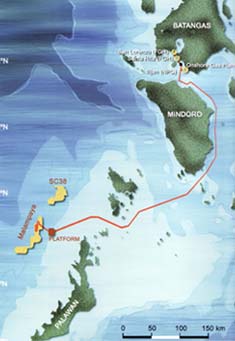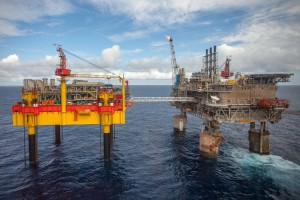
A new depletion compression platform at the Malampaya gas field will keep lights burning in Manila for years to come. Upstream Technology’s Russell McCulley talks to Shell about the landmark project’s latest development phase and the technical and logistical challenges involved.
It is difficult to overstate how important the Malampaya Deep Water Gas-to-Power project is to the Philippines. Since production began in 2001, the joint venture of Shell Philippines Exploration, operator, and partners Chevron Malampaya and Philippine National Oil Company-Exploration Corporation has generated billions of dollars in revenue for the national government, reduced the country’s energy imports by an estimated 30%, and provided a powerful symbol of cooperation between the public and private sectors in a nation eager to promote a business-friendly environment to international investors.
More critically, the development provides between 35% and 40% of the energy supply to Luzon province, which includes Metro Manila and its roughly 12 million inhabitants.
“It is really the only significant upstream resource in the Philippines,” says Antoine Bliek, Shell’s project manager for Malampaya Phase 2 and 3. “We always say that one lamp in every three in Manila is kept on by gas from Malampaya.”
For that reason, when planning began several years ago for Malampaya’s second and third development phases, Shell and its partners were under considerable pressure to see that any service interruptions were kept to a minimum.
Malampaya Phase 2, which added two infill wells to maintain pressure and production, was completed last year. Phase 3, to be completed by the end of 2015, includes a new depletion compression platform (DCP), which Shell claims is the first gas platform to be built entirely in the Philippines.
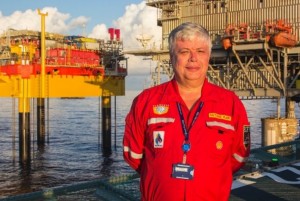
“One lamp in every three in Manila is kept on by gas from Malampaya.” – Antoine Bliek, Shell
It is difficult to overstate how important the Malampaya Deep Water Gas-to-Power project is to the Philippines. Since production began in 2001, the joint venture of Shell Philippines Exploration, operator, and partners Chevron Malampaya and Philippine National Oil Company-Exploration Corporation has generated billions of dollars in revenue for the national government, reduced the country’s energy imports by an estimated 30%, and provided a powerful symbol of cooperation between the public and private sectors in a nation eager to promote a business-friendly environment to international investors.
More critically, the development provides between 35% and 40% of the energy supply to Luzon province, which includes Metro Manila and its roughly 12 million inhabitants.
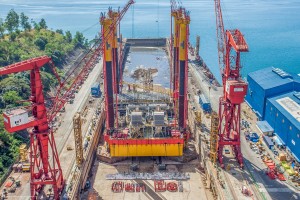
The DCP, under construction at Keppel’s Subic Shipyard, has 80-metre legs that are lowered for self-installation.
“It is really the only significant upstream resource in the Philippines,” says Antoine Bliek, Shell’s project manager for Malampaya Phase 2 and 3. “We always say that one lamp in every three in Manila is kept on by gas from Malampaya.”
For that reason, when planning began several years ago for Malampaya’s second and third development phases, Shell and its partners were under considerable pressure to see that any service interruptions were kept to a minimum.
Malampaya Phase 2, which added two infill wells to maintain pressure and production, was completed last year. Phase 3, to be completed by the end of 2015, includes a new depletion compression platform (DCP), which Shell claims is the first gas platform to be built entirely in the Philippines.
Self-installation
Three factors influenced the final development decisions, Bliek says. The first consideration was the need to minimise service interruptions from the existing platform.
“Second, (Malampaya) sits in 45 metres of water on calcareous soils, so it is very difficult to use a piled foundation. It requires some other type of foundation. And third, it’s a very remote site with little upstream infrastructure or lifting capacity in the region,” he explains. “So we didn’t want to do any kind of extra lifts, added hook-up and commissioning, things like that.
“We selected a concept that is self-installable, that is constructed as a whole, that could be moved next to the existing platform with minimal disruption of production, and installed quickly without lifts.”
Unlike the concrete gravity based platform, the DCP’s 7750-tonne substructure rests on steel footings. The 3300-tonne topsides include two 100% compressors from Siemens driven by Rolls-Royce RB211 turbines, air cooler modules, a utility module, equipment room, pipe rack and a deck crane. The new platform is linked by 43-metre bridge, also designed by Arup, to the original Malampaya platform.
Calcareous sands were not the region’s only challenge, says Martyn Turner, Shell’s design team lead for the depletion compression project.
“I think it’s worth remembering that, as you come further north in the Philippine Islands, you’re in a seismic region and also in a typhoon region. So one of our challenges was designing for both.”
To mitigate risk, the DCP had to be designed with an air gap of 23 metres, which meant installation options were limited, he says.
“That was one of the challenges around the installation. The lift barge capability in the region is not geared up for lifts that high. So that was another reason for the selection of a self-installing platform.”
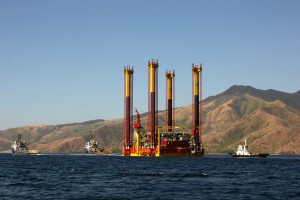
The DCP being towed out of Subic Bay. More than 1200 workers took part in the two-year construction.
Minimal downtime
Shell chose a design that would minimise downtime for the production platform, and timed installation to coincide with a scheduled maintenance shutdown, Turner says.
“We took various decisions, such as going with air coolers, so that we minimised the number of tie-ins. We added our own local equipment to make sure that we could maximise all of our pre-commissioning prior to leaving the Keppel yard,” he explains.
“Interruption would be a huge issue. If you look more traditional approaches, where you have a number of fields producing into the grid —say, in areas like the North Sea, where you can afford to have a couple of months shutdown to do a tie-in—here, we don’t have that luxury. So everything was geared up to make sure we were as complete as we could be before we left the yard.”
The platform was installed in February, followed by a planned 30-day maintenance shutdown, during which the major tie-in work was completed. Some 550 workers were offshore at the peak of activity, with Prosafe’s Safe Astoria semisub on hand to provide accommodations.
During a 48-hour procedure, the platform was lowered into place and temporary bridge access installed. Gas production remained online during the operation.
The 150-tonne permanent bridge was lifted into place using strand jacks temporarily installed on the DCP and existing platform. In order to minimise the risk of snatch loading—the sudden tensioning of a slack cable—Boskalis turned to Dutch firm Barge Master, and its new BM-T700 motion compensated lifting system mounted on the deck of Boskalis’ construction vessel Ndeavor. The operation marked the first commercial use of the system, says Barge Master CEO Martijn Koppert.
More than 1200 workers were involved in the two-year construction of the DCP.
“We were quite keen to maximise local content and do what we could in country,” says Bliek. “Capability is growing fast in the Philippines. We supplied our own expertise to the contractors, but I think the fact that the project was delivered as scheduled is proof that, yes, this can now be done. It’s quite an achievement.”
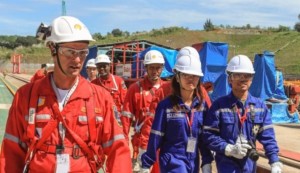
Gas supply interruption would be a huge issue. – Martyn Turner, Shell (at Keppel Subic yard)
This article was first published in Upstream Technology.



